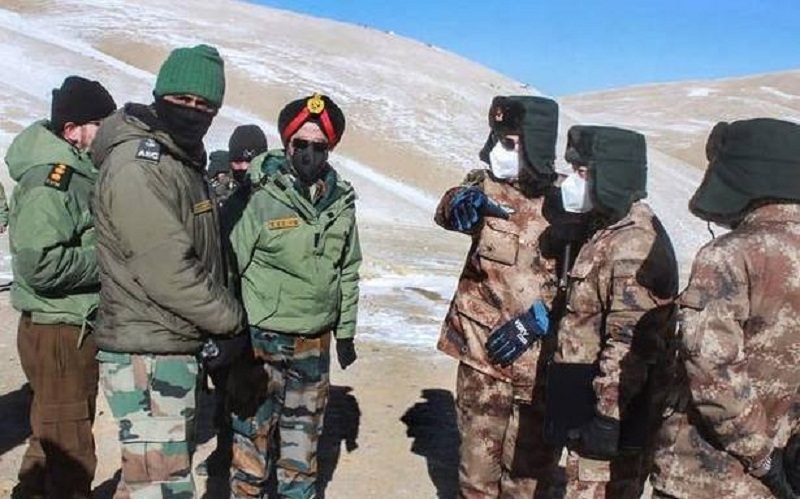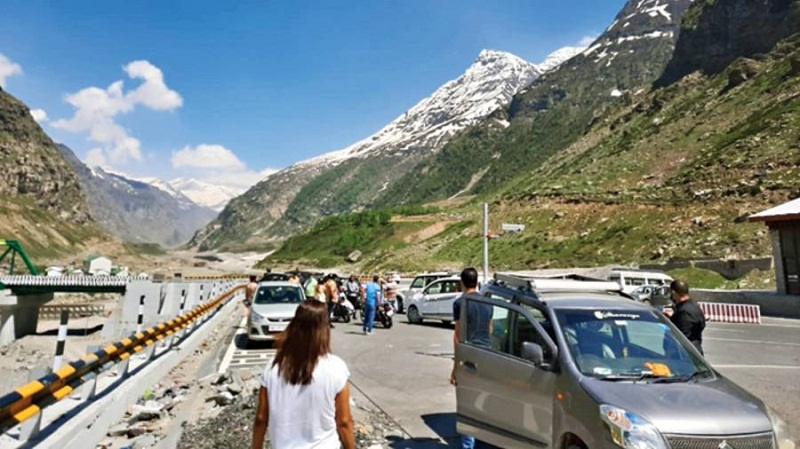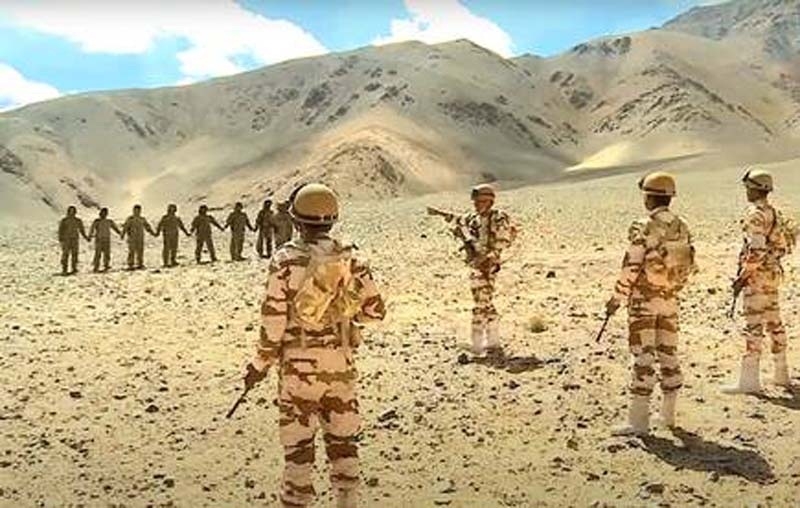Deadlock over Sino-Indian border talks

Deadlock or stalemate over Corps Commander-level talks is on scripted Chinese lines. If deadlock persists with China despite Xi-Jinping-Modi bromance at Ahmedabad (2014), two informal summits at Wuhan (Wuhan Spirit) and Mamallapuram (Chennai Connect)), and their meetings on the side lines of various international forums like BRICS, it should surprise none.
Both nations face fundamental strategic dilemmas that are irreconcilable: the clash of national values. China is a ‘totalitarian’ state, which is homogenous socially. In contrast, India is a democracy and a multicultural society full of contradictions and controversies. Most important, China wants to maintain its status as the Asia-Pacific’s sole “Middle Kingdom.”
As the old Chinese saying goes, “one mountain cannot accommodate two tigers.” Also, Chinese view outstanding border disputes as ‘accidents of history’ to be resolved in its favor. An unsettled border provides China the strategic leverage to keep India uncertain and to ensure New Delhi’s “good behavior” on issues of vital concern. China does not want to give up the “bargaining chip” that an unsettled boundary India provides.
Historically and culturally, India never played second fiddle to China. India too perceives itself as the dominant power of the South Asia region. Also the Indian belief that China is seeking to deny India proper stakes in the game of international politics as evidenced from its opposition to India’s membership in the P - 5 (UN Security Council), N- 5 (Nuclear Club), and so on. In particular, India views the Sino-Pakistani nexus, besides its forays into Nepal, Bangladesh, Sri Lanka, Myanmar and the Indian Ocean region as hostile and threatening in nature.
In sum, the geo-strategic dilemmas are, therefore, real. Neither power is comfortable with the rise of the other. If one country sees its own actions as self-defensive, the same appears aggressive to the other country. Therein lays the root cause of volatile/strained relationship.
Relations have been tense ever since a border dispute led to a full- scale war in 1962, armed skirmishes in 1967 and 1987 and series of border clashes in recent past. There are currently 14 areas under dispute - eight in the Western sector and six in the Eastern sector viewed as the most important disputed areas- shift from the past.
So, it is no surprise that the recent 13th round of Corps Commander-level talks failed to resolve border issues. The Indian Army, in a statement, said it gave “constructive suggestions” but the Chinese side was “not agreeable”. They also could not provide any forward-looking proposals, the Indian Army said.
Rebutting, the Chinese People's Liberation Army (PLA) Western Theater Command stated that “India made unreasonable and unrealistic demands, adding difficulties to the negotiations.” Furthermore, Chinese observers blamed India for triggering new incidents along the eastern section of the border recently.
More importantly, the ‘Global Times’ in its editorial opined “The harshly worded statement issued by the Chinese government on China and India failing to reach an agreement during their latest round of corps commander-level talks showed China's subtle change of attitude toward India, and the country's staunch determination to protect its territorial and sovereign integrity.”
As for the nature of the ‘unreasonable’ and ‘unrealistic’ demands, Lin Minwang, professor with the Institute of International Studies at Fudan University, told the ‘Global Times’ that India had proposed returning to the pre-April 2020 positions in the western section along the Line of Actual Control (LAC), which Lin said is totally unreasonable for China.
When asked to comment on the statement from the Indian Ministry of Defence statement, Zhao Lijian, spokesperson of China's Ministry of Foreign Affairs, said that India's statement is baseless. China has made great efforts and demonstrated sincerity in de-escalating the border issue with India, yet India has insisted on making unrealistic demands, Zhao said. China has made quite clear its attitude of safeguarding its territorial and sovereign integrity, so if India fails to learn the lesson this time, or ante up its aggressive behavior, China will fight until the end, said Qian.
Viewed in above content, there is no question of a breakthrough in future? To develop a balanced view, one must have thorough understanding of China's “Grand Strategy” and “Military Strategy”.
China views the boundary dispute as a “legacy of history - when China was weak and the Western Powers imposed unfair treaties.” There are currently 14 areas under dispute - eight in the Western sector and six in the Eastern sector. The Chinese now identify the eastern sector as the most important disputed area, a shift from their position of several decades. And, India does not accept de facto administration of China in Aksai Chin and territories ceded by Pakistan in 1964.
Since December 1981, border negotiations have been endlessly going between the two countries. The Agreements signed between the two countries include: 1993, 1995, 2003, 2005, 2006, 2007, 2012, and 2013. In 1993, Agreement on the Maintenance of Peace and Tranquility along the LAC was signed. Followed in 1996, the Confidence Building Measures (CBM) Agreement.
In 2003 Vajpayee and Premier Wen Jiabao signed a Declaration on Principles for Relations and Constructive Cooperation between our two countries. The third principle states: “The two countries are not a threat to each other. Neither side shall use or threaten to use force against the other.” This was more than reiterated in the agreement signed in April 2005 on the Political Parameters and Guiding Principles for settlement of the India China boundary question. Article 1 state, inter alia: “Neither side shall use or threaten to use force against the other by any means.”
Even the Special Representatives (SRs) on the Boundary Question (Diplomatic level talks and negotiations) was formalized. India and China committed themselves to clarification and confirmation of the LAC to reach a common understanding of the alignment. However, this process has made little progress since 2003. Both sides have so far exchanged maps only in the central sector, leading to overlapping claims at several points due to “differences in perception”.
Then followed the 2005 Agreement on the Guiding Principles for Settlement and Protocol and the Modalities for the Implementation of CBMs in the Military Field along the LAC. In 2006, both countries expressed desire for the early settlement of the boundary in question by including it as one of “outstanding issues” in the “Ten-pronged Strategy”. In 2007, institutionalization of the establishment of an Annual Defence Dialogue.
In 2012, Agreement for the “Establishment of a Working Mechanism for Consultation and Coordination on China-India Border Affairs” was signed. Finally in October 2013, the Border Defence Cooperation Agreement (BDCA) for both armies to “exercise maximum self-restraint” if a face-to-face situation develops, as also have the right to “seek a clarification from the other side” if “a doubtful situation arises” where there is “no common understanding” of the LAC was signed. Article VI of the agreement prohibits either side from tailing the patrols of the other “in areas where there is no common understanding of the line of actual control”.
Recently, there has been a change in China's position from solving the border dispute ‘immediately’ in 1982-83 to ‘ultimately’ now, stating that it was a complicated issue and would be solved by the next generation. While Chinese insist on the return of Tawang (the birthplace of the sixth Dalai Lama) on religious grounds, Indians seek the return of the sacred Mount Kailash-Mansarovar in Tibet. China is in no ‘great hurry’ to resolve the border issue.
In retrospect, four decades of talks, including over 22 sessions at the level of Special Representatives, have not succeeded in making China agree to the delineation of LAC on maps pending final boundary solution. There is not even an agreed perception of “disputed areas.”

Xi Jinping modified the goal posts to 2049 with focus on changing ‘great power relations’ as equal to the US by emerging as a strong and dominant power while exploiting the ‘window of opportunity’ that may be available to pursue ‘peaceful development path’ to realize “Chinese Dream” of rejuvenation of the Middle Kingdom. Xi Jinping and the CCP have defined “Core National Interests and Objectives” unambiguously. Officially, China claims that it has no hegemonic designs and believes in world peace.
When China attains its goal of real “Super Power” status by 2049 (earlier or later), none can rule out the prospect of China asserting hegemony over Asia Pacific region and interventionist role globally to safeguard its “Core National Interests.”
The Chinese cumulative military wisdom is borne out of “Seven Military Classics” espousing the Eastern tradition of strategic thought between 500 BC and AD 700 that emphasizes outwitting one's opponent through speed, stealth, flexibility and minimum use of force, an approach very different from the brute force that is stressed by the Western military thought, still governs Chinese strategists psyche. The “Science of Military Strategy”, the prescribed text book, has borrowed cumulative historical wisdom on strategy. Sun Tzu’s dictum over 2000 years ago: “winning wars without waging battles”- the acme of strategic excellence, profoundly influences current strategic military thought.
Of course, crisis and conflict situations round the globe have cumulatively influenced shifts in Chinese military strategies from time to time, particularly from quantity to quality to include: defensive land-centric and coast dependent naval strategy to offensive and naval “far-sea” strategy; creeping incrementalism and extended coercion; “Unrestricted Warfare or Hybrid” warfare - combining conventional, nuclear, irregular, information, and cyber and space warfare - transforming to ‘Gen 5’ warfare.
By 1985, with improvement of relations with the Soviets, the PLA changed from being constantly prepared to "hit early, strike hard and to fight a nuclear war" to developing PLA in an era of peace. After the Kuwait War, China, under Jiang Jemin, realized sophistication and effectiveness of long-range, precise, smart, stealthy and unmanned weapons and equipment and the Informatization warfare. In 1993, the “Revolution in Military Affairs” (RMA) was made part of the official national military strategy.
Next, in late 1990s, the credit for the enunciation of ‘Unrestricted Warfare’ to explore how technology innovation is setting off a revolution in military strategy, doctrines and organization goes to two senior PLAAF colonels. “Unrestricted Warfare” discusses new types of warfare which may be conducted by civilians as well as by soldiers including computer hacker attacks, trade wars and finance wars. The strategic shift is from the classical “communist-centric unconventional warfare” of sponsoring and extending support to communist inspired insurgents to “Unrestricted Warfare” or “Creeping Covert Warfare.”
Later, only US thinkers categorized such shifts in warfare as “Hybrid” warfare, which is a military strategy that blends nuclear warfare, information warfare, conventional warfare, irregular warfare and cyber warfare. “Hybrid” warfare can be used to describe the flexible and complex dynamics of the battle space requiring highly adaptable and resilient responses. Most importantly, some view it as the contemporary form of guerrilla warfare that “employs both modern technology and modern mobilization methods.”
Military strategies synergizing employment of PLA to conduct full spectrum operations are in full play. It includes Space and Cyber warfare, combat doctrines at operational art level and concepts at tactical level, force restructuring through substantial downsizing of personnel and obsolete combat equipment and induction of state-of-the art strategic and tactical combat systems.
On the military doctrinal front, its designs are clear. Active Defense, Local Wars under conditions of Informatization and People’s war flows out of its land and sea offensive strategy. Not only they can deter aggressors in local under conditions of Informatisation, but also teach a lesson to potential aggressors undertaking military adventures. China’s strategic mobility to deploy RRUs from one “Theatre Command to another Command” reflects all round offensive capability to concentrate its forces at the most critical front with least delay.
China’s research – maneuvering re-entry vehicles (MaRV), multiple independently targeted re-entry vehicles (MIRV), decoys, chaff, jamming, thermal shielding, and ASAT weapons, will strengthen deterrent and strategic strike capabilities.
Currently, China has recognized that nuclear, seas, outer space, cyber, and C6ISR systems (Command, Control, Communications, Computers, Cyber Defense, Intelligence, Surveillance and Reconnaissance) are the new security domains in today’s ongoing technology civilization. In the “Nuclear” domain, China is progressively enhancing its “TRIAD” and second strike capabilities. In the “Sea” domains, China is accelerating its efforts to acquire sophisticated anti-ship missiles, aircraft careers and submarines. It is to strike at hostile career based fleets inside the “first island chain”. It has acquired capability to reach beyond the so-called “second island chain” to the US base on Guam.
In the ‘Space” domain, China is expanding its space-based surveillance, reconnaissance, navigation, meteorological, and communications satellite constellations. In the ‘Cyber’ domain, China is using cyber network operations (CNOs) as a tool to collect strategic intelligence. Chinese reportedly envision the mobilization of millions of citizens skilled in IT applications as new heroes in the new “Peoples War”.
In the C6ISR domain, China is building modern C6ISR necessary to fight and win “local wars under informatized conditions.” China is acquiring advanced land, air, sea, and space-based C6ISR capabilities - reliable, survivable, interoperable, and integrated systems, to enhance battlefield awareness; identify, track, and engage military targets deep into the western Pacific Ocean; and, streamline supply and logistics.
China is incrementally and progressively building its hard power to build a “strong army to become a dominant power in global affairs by 2049”, to engage in full spectrum operations of Gen 5/6 warfare scenarios. The reorientation of its military strategy – active defense from purely defensive strategic posture to offensive operational posture or action in order to thwart an invader is a significant shift. No more, a military strike, per se, prompts a Chinese military response; actions in the political and strategic realm may justify the PLA firing the first shot tactically. It is in the forefront of orchestrating a perfect symphony of the new domains - aero space, maritime and land with alacrity.

In sum, in the foreseeable future, India-China ties will, therefore, remain fragile and as vulnerable as ever to sudden deterioration as a result of misperceptions, postures, accidents, and eruption of unresolved issues. However, in the short term, China may not do anything that destabilizes bilateral relationship or arouses the suspicions of their smaller Asian neighbors. Their efforts will be aimed at consolidating their power and position while striving to resolve more pressing domestic problems. However, China will continue to implement its strategy of “Creeping Incrementalism and Extended Coercion” to assert its stated policy: “accidents of history” to be resolved by the next generation.
In the mid and long terms, neither Indian nor Chinese defence planners can rule out the possibility of a renewed confrontation over Tibet, Kashmir, Myanmar, or in the Indian Ocean. A Sino-Indian rivalry in southern Asia and the northern Indian Ocean (especially the Malacca Straits) may well be a dominant feature of future Asian geopolitics of the twenty-first century.
Judging by the past leadership behavior, how China will play its role as a great power will depend on in changes in post Xi Jinping’s era after 2023 or 2028. All one can say with certainty is Xi Jinping will employ all ‘soft power’ skills to gain great power status and may not enter into wars considered detrimental to its national interests in the immediate or short term contexts, but continue to up the military confrontation. How Chinese leadership after 2025 would behave - more aggressive, coercive, offensive and active in both regional and global spheres - only posterity can reveal. Certainly, they will play a more hegemonic role in international affairs having achieved economic and technological superpower status by then with their “Soft Power” doing political neutralization of USA in Latin America or Africa or the Middle East.
So, India must accordingly adopt a military strategic posture appropriate to Chinese postures.
